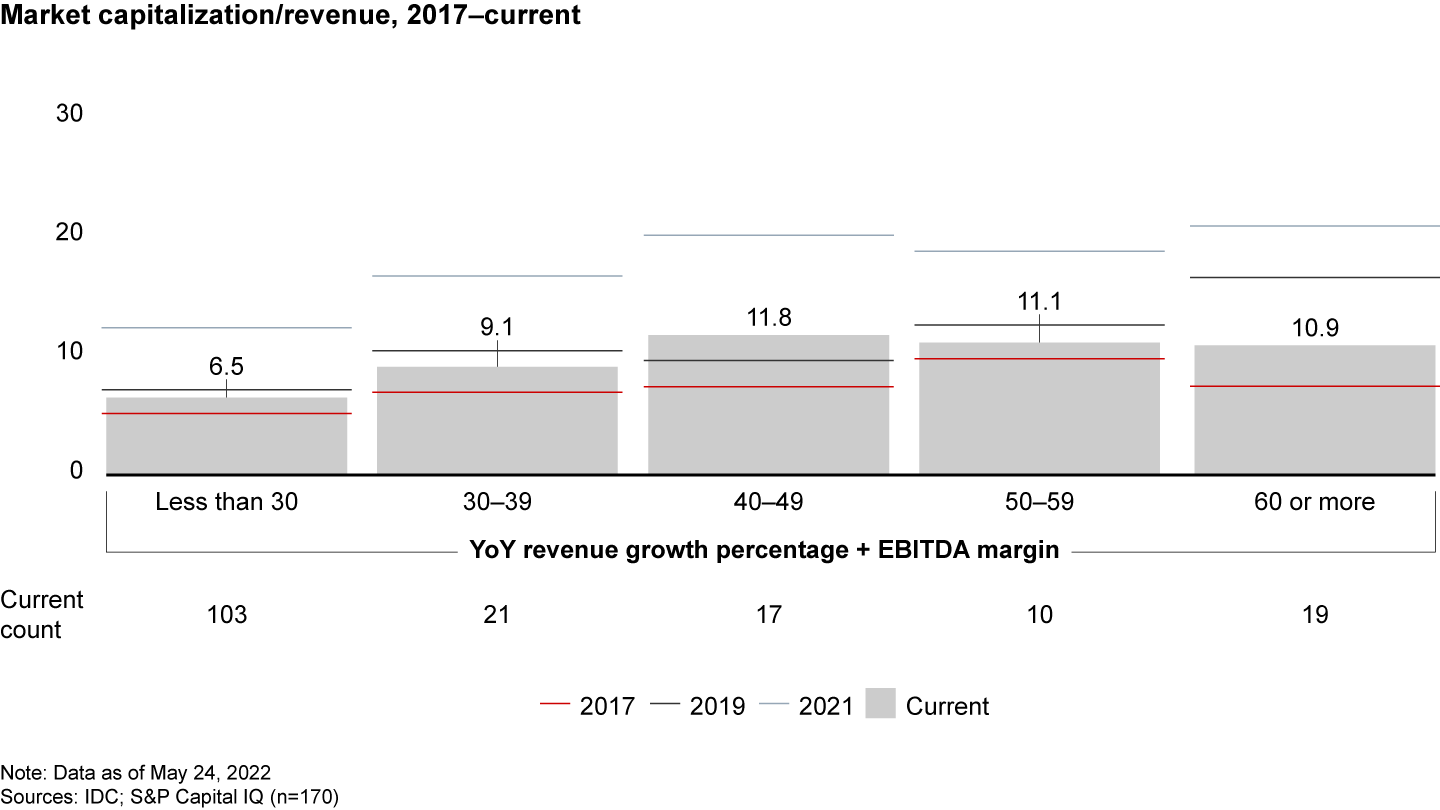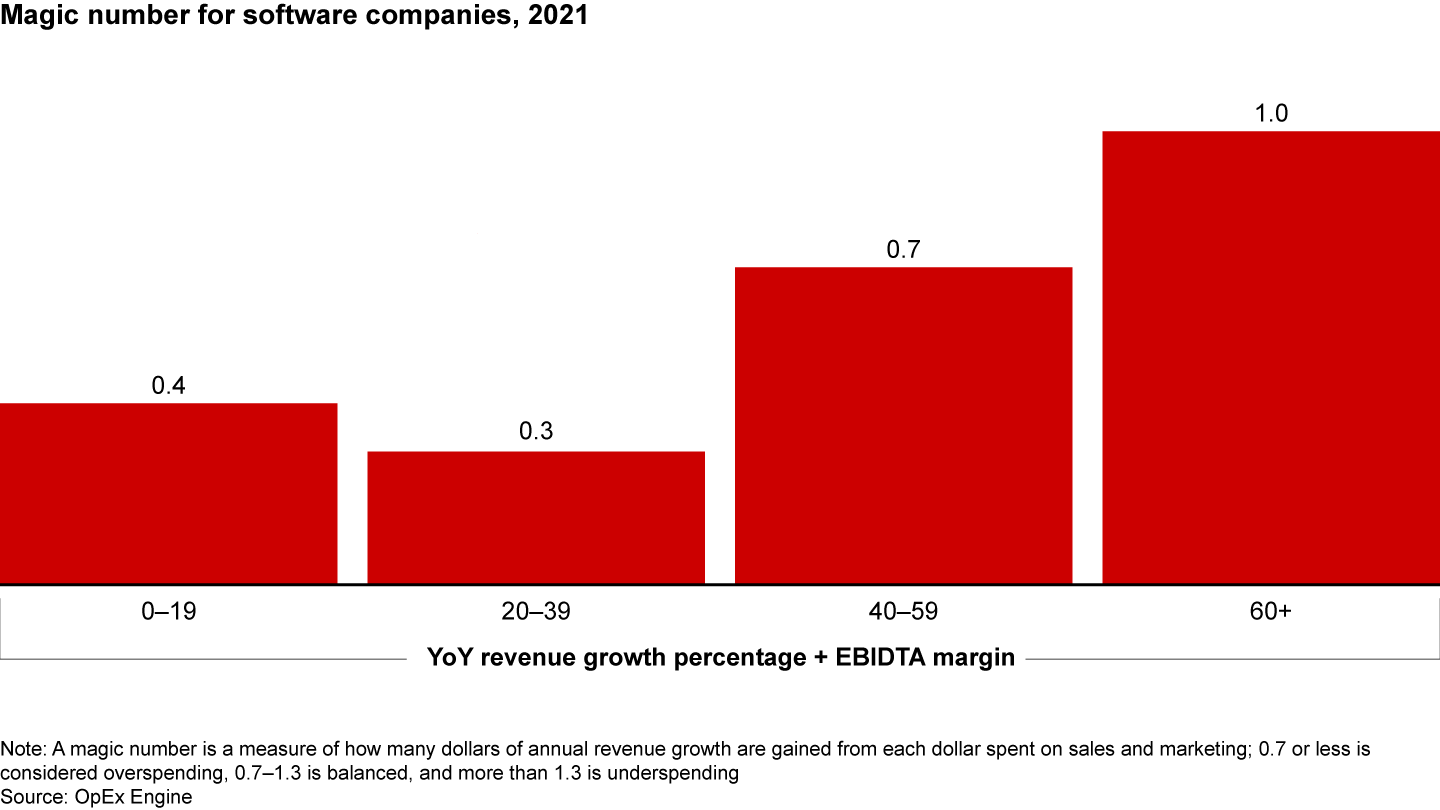Technology Report
 }
}
Резюме
- New market leaders have emerged that are far exceeding the performance gold standard Rule of 40, hitting numbers in the 50s, 60s, and even 80s.
- Bain has identified four archetypes among these superperformers.
- By using their archetype to tune investment in products and sales and marketing, companies can set an ambitious, yet realistic, performance target.
This article is part of Bain's 2022 Technology Report.
Even with recent stock market fluctuations, the growth and profitability of leading software companies remains strong by historical standards. When a company’s year-on-year revenue growth rate and its earnings before interest, taxes, depreciation, and amortization (EBITDA) margin add up to 40, a company is balancing growth and profitability well. Recently, new market leaders have emerged that are far exceeding even that strong performance (see Figure 1) and doing so in all market conditions (see Figure 2).
This has left executives asking two questions: How high should our target be? And how can we achieve it? The answers lie in better understanding what these superperformers are doing.

Four archetypes of superperformers
Not every company can realistically aim to exceed the Rule of 40, but through our research and experience in the market, we have identified four archetypes of companies that can, and often do, perform significantly above that, and some companies fit more than one type.
- Hypergrowers. Companies that fit this type include Datadog (73) in observability, CrowdStrike (61) in cybersecurity, and IT service management company ServiceNow (now 43 following a higher-growth period). All reached leadership scale rapidly and have made the most of market growth and their superior competitive value proposition, distributing their product to rapidly gain share and install a customer base that will be their most important asset in the long run.
- Product-led growth. Companies like online meeting platform Zoom (83), observability platform Dynatrace (47), and signature platform DocuSign (46) set themselves apart by investing in valued product attributes, marketing, and pricing. They enable users to discover, download, adopt, and expand use of their product, often without ever having to involve a sales rep. Product-led growers are 1.5 times as likely to be above 40 as the typical company in our data set. Product-focused outperformers that are also hypergrowers include cloud warehouse Snowflake (49), application creation and work management platform Monday.com (51), and Datadog.
- Category champions. Software giant Microsoft (70) and digital media and marketing company Adobe (63) built sustained, highly profitable businesses around dominant core products. There are also many private companies, often industry-focused, that operate in more protected niches and enjoy strong pricing and lower competition.
- Consumer and small to midsize digital winners. Companies like cybersecurity software maker Avast (52) and Adobe sell digitally to small to midsize businesses or consumers, and with a streamlined cost structure, achieve strong growth and scale rapidly.
Even for companies with outsized growth or profitability, consistent performance is not a given. The stock prices of a number of these companies have dropped in recent months, for example, as inflation and the overall stock market adjustment has hit high-growth businesses particularly hard. The question of how much they can continue to grow must be revisited often, and for businesses that are decelerating, this can be challenging.

Due Diligence
We help investors make better decisions by thoroughly assessing a target's full potential.
How to achieve your target
Once a company has understood and appropriately defined its growth potential and set a Rule of 40, 50, or 60+ target, the next challenge is achieving it. That comes down to two things: (1) effectively managing sales and marketing expense and (2) achieving high returns on research-and-development spending.
Effectively manage sales and marketing expenses. Sales and marketing is often the largest item on any company’s profit-and-loss statement and the one function that most governs the top line. A key operational measure for managing profitable growth is the so-called magic number, which measures how many dollars of annual revenue growth are gained from each dollar spent on sales and marketing (see Figure 3). Companies with low growth and systematically poor performance have low magic numbers because they haven’t adjusted their sales and marketing spending to their slower growth rate. Higher-growth businesses can often significantly improve their magic number either through improved coverage models or digital tools.

Many small to midsize and consumer businesses wish to expand digital customer journeys and use test-and-learn techniques to improve those journeys over time. Ease of interacting or purchasing should always be top of mind, but using self-service to streamline sales, deploying digital training and trigger-based product exploration, and integrating marketing into products with a philosophy of “see, try, buy” all offer an opportunity to reduce sales and marketing costs while increasing customer satisfaction.
Such steps can boost a low magic number, but a magic number that’s too high is also a warning sign. The business may be playing it too safe and not fully exploiting the growth opportunity, even when growth is quite high. Boosting investments in sales, then marketing that well-established growth opportunity, can improve overall performance even more.
Embed marketing and selling into the product experience. What a company spends on its products vs. sales and marketing doesn’t capture all the factors that affect a software company’s performance, but this is an increasingly popular comparison that sheds light on how some companies are meeting and exceeding the Rule of 40.
Datadog is a prime example of a company that has grown quickly and achieved strong performance by investing in its products and pursuing product-led growth. With an EBITDA margin of zero, Datadog exceeded a Rule of 70 in 2021, spending 40% of its revenue on R&D and 30% on sales and marketing, the opposite of what most companies do. Datadog’s IT monitoring products are designed so customers start with a free trial but can easily increase the number of workloads, taking advantage of more than 500 vendor-backed integrations in their observability platform. This investment in the product experience has helped revenue grow 70%, while lowering the amount spent on sales and marketing as a percentage of revenue.
Whatever a company’s performance goal, whether the Rule of 40 or something higher, that aspiration should be grounded in a realistic view of its growth opportunity. Companies can begin their evaluation by carefully identifying and setting their growth and EBITDA targets, based on what’s appropriate for their archetype, then launch into the work of improving sales and marketing productivity and pursuing product-led growth.

